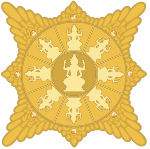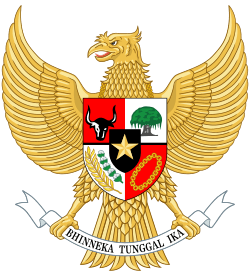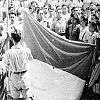Indonesian National Revolution
The Indonesian National Revolution, or Indonesian War of Independence, was an armed conflict and diplomatic struggle between the Republic of Indonesia and the Dutch Empire and an internal social revolution during postwar and postcolonial Indonesia. It took place between Indonesia's declaration of independence in 1945 and the Netherlands' recognition of Indonesia's independence at the end of 1949.
| Indonesian National Revolution | |||||||
|---|---|---|---|---|---|---|---|
| Part of the Decolonisation of Asia and Cold War | |||||||
 The Dutch Queen Juliana signs the document transferring sovereignty to the United States of Indonesia in The Hague, 27 December 1949 | |||||||
| |||||||
| Belligerents | |||||||
|
|
| ||||||
| Commanders and leaders | |||||||
|
| ||||||
| Strength | |||||||
| |||||||
| Casualties and losses | |||||||
| British Raj defectors: 525 dead[4] | |||||||
| Casualties for Indonesia includes both Military and Civilian | |||||||
The four-year struggle involved sporadic but bloody armed conflict, internal Indonesian political and communal upheavals, and two major international diplomatic interventions. Dutch military forces (and, for a while, the forces of the World War II Allies) were able to control the major towns, cities and industrial assets in Republican heartlands on Java and Sumatra but could not control the countryside. By 1949, international pressure on the Netherlands and the partial military stalemate became such that it recognised Indonesian independence.[12]
The revolution marked the end of the colonial administration of the Dutch East Indies, except for Netherlands New Guinea. It also significantly changed ethnic castes as well as reducing the power of many of the local rulers (raja). It did not significantly improve the economic or political fortune of the majority of the population, although a few Indonesians were able to gain a larger role in commerce.
Background
The Indonesian independence movement began in May 1908, which is commemorated as the "Day of National Awakening" (Indonesian: Hari Kebangkitan Nasional). Indonesian nationalism and movements supporting independence from Dutch colonialism, such as Budi Utomo, the Indonesian National Party (PNI), Sarekat Islam and the Indonesian Communist Party (PKI), grew rapidly in the first half of the 20th century. Budi Utomo, Sarekat Islam and others pursued strategies of co-operation by joining the Dutch initiated Volksraad ("People's Council") in the hope that Indonesia would be granted self-rule.[13] Others chose a non-cooperative strategy demanding the freedom of self-government from the Dutch East Indies colony.[14] The most notable of these leaders were Sukarno and Mohammad Hatta, two students and nationalist leaders who had benefited from the educational reforms of the Dutch Ethical Policy.
The occupation of Indonesia by Japan for three and a half years during World War II was a crucial factor in the subsequent revolution. The Netherlands had little ability to defend its colony against the Japanese army, and within only three months of their initial attacks, the Japanese had occupied the Dutch East Indies. In Java, and to a lesser extent in Sumatra (Indonesia's two dominant islands), the Japanese spread and encouraged nationalist sentiment. Although this was done more for Japanese political advantage than from altruistic support of Indonesian independence, this support created new Indonesian institutions (including local neighbourhood organisations) and elevated political leaders such as Sukarno. Just as significantly for the subsequent revolution, the Japanese destroyed and replaced much of the Dutch-created economic, administrative, and political infrastructure.[15]
On 7 September 1944, with the war going badly for the Japanese, Prime Minister Koiso promised independence for Indonesia, but no date was set.[16] For supporters of Sukarno, this announcement was seen as vindication for his collaboration with the Japanese.[17]
Independence declared
Under pressure from radical and politicised pemuda ('youth') groups, Sukarno and Hatta proclaimed Indonesian independence, on 17 August 1945, two days after the Japanese Emperor's surrender in the Pacific. The following day, the Central Indonesian National Committee (KNIP) elected Sukarno as President, and Hatta as Vice-President.[18][19][20]
PROCLAMATION
We, the people of Indonesia, hereby declare the independence of Indonesia.
Matters which concern the transfer of power etc. will be executed by careful means and in the shortest possible time.
Djakarta, 17 August 1945[21]
In the name of the people of Indonesia,
[signed] Soekarno—Hatta
(Translation by the Ministry of Foreign Affairs, October 1948)[22]
Revolution and Bersiap
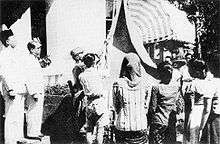
It was mid-September before news of the declaration of independence spread to the outer islands, and many Indonesians far from the capital Jakarta did not believe it. As the news spread, most Indonesians came to regard themselves as pro-Republican, and a mood of revolution swept across the country.[23] External power had shifted; it would be weeks before Allied Forces shipping entered Indonesia (owing in part to boycotts and strikes, in Australia, on coaling, loading and manning Dutch shipping from Australia where the Netherlands East Indies Government in exile was based). These strikes were only fully broken in July 1946.[24] The Japanese, on the other hand, were required by the terms of the surrender to both lay down their arms and maintain order; a contradiction that some resolved by handing weapons to Japanese-trained Indonesians.[25][26]
The resulting power vacuums in the weeks following the Japanese surrender, created an atmosphere of uncertainty, but also one of opportunity for the Republicans.[25] Many pemuda joined pro-Republic struggle groups (badan perjuangan). The most disciplined were soldiers from the Japanese-formed but disbanded Giyugun (PETA, volunteer army) and Heiho (local soldiers employed by Japanese armed forces) groups. Many groups were undisciplined, due to both the circumstances of their formation and what they perceived as revolutionary spirit. In the first weeks, Japanese troops often withdrew from urban areas to avoid confrontations.[27]
By September 1945, control of major infrastructure installations, including railway stations and trams in Java's largest cities, had been taken over by Republican pemuda who encountered little Japanese resistance.[27] To spread the revolutionary message, pemuda set up their own radio stations and newspapers, and graffiti proclaimed the nationalist sentiment. On most islands, struggle committees and militia were set up.[28] Republican newspapers and journals were common in Jakarta, Yogyakarta, and Surakarta, which fostered a generation of writers known as angkatan 45 ('generation of 45') many of whom believed their work could be part of the revolution.[27]
Republican leaders struggled to come to terms with popular sentiment; some wanted passionate armed struggle; others a more reasoned approach. Some leaders, such as the leftist Tan Malaka, spread the idea that this was a revolutionary struggle to be led and won by the Indonesian pemuda. Sukarno and Hatta, in contrast, were more interested in planning out a government and institutions to achieve independence through diplomacy.[29] Pro-revolution demonstrations took place in large cities, including one in Jakarta on 19 September with over 200,000 people, which Sukarno and Hatta, fearing violence, successfully quelled.[30]
By September 1945, many of the self-proclaimed pemuda, who were ready to die for '100% freedom', were getting impatient. It was common for ethnic 'out-groups' – Dutch internees, Eurasian, Ambonese and Chinese – and anyone considered to be a spy, to be subjected to intimidation, kidnap, robbery, murder and organised massacres. Such attacks would continue throughout the course of the revolution, but were most present during the 1945–46 period, which is known as the Bersiap.[31][32][33]
After the Bersiap in 1947 Dutch authorities attempted to retrieve the bodies of the victims and several survivors of the period provided legal testimony to the Attorney General office. Due to continued revolutionary warfare few bodies were found and few cases came to court. Around 3,500 graves of Bersiap victims can be found in the Kembang Kuning war cemetery in Surabaya and elsewhere.
The Simpang Society Club Surabaya was appropriated by the Pemudas of the Partai Rakyat Indonesia (P.R.I.) and made into the headquarters of P.R.I. commander Sutomo, who personally supervised the summary executions of hundreds of civilians. An archived eyewitness testimony of the events of 22 October 1945 states:
Before each execution Sutomo mockingly asked the crowd what should be done with this "Musuh (enemy) of the people". The crowd yelled "Bunuh!" (kill!) after which the executioner named Rustam decapitated the victim with one stroke of his sword. The victim was then left to the bloodthirst of boys 10, 11 and 12 years old. ...[who] further mutilated the body." "Women were tied to the tree in the back yard and pierced through the genitals with "bambu runcing" (bamboo spears) until they died.
On Sutomo's orders the decapitated bodies were disposed of in the sea, the women were thrown in the river.[34] The death toll of the Bersiap period runs into the tens of thousands. The bodies of 3,600 Indo-Europeans have been identified as killed. However more than 20,000 registered Indo-European civilians were abducted and never returned. The Indonesian revolutionaries lost at least 20,000, often young, fighting men. Estimates of the number of Indonesian fighters killed in the lead up and during the Battle of Surabaya range from 6,300 to 15,000.[35] The Japanese forces lost around 1,000 soldiers and the British forces registered 660 soldiers, mostly British Indians, as killed (with a similar number missing in action).[36] The actual Dutch military were hardly involved,[37] as they only started to return to Indonesia in March and April 1946.
Formation of the Republican government
Republic of Indonesia Republik Indonesia | |||||||||
|---|---|---|---|---|---|---|---|---|---|
| 1945–1949 | |||||||||
 | |||||||||
| Capital | Djakarta (1945–1946) Yogyakarta (1946–1948) | ||||||||
| Capital-in-exile | Bukittinggi (1948–1949) | ||||||||
| Common languages | Indonesian | ||||||||
| Government | Presidential republic (Aug.–Nov. 1945) Parliamentary republic (1945–1949) | ||||||||
| President | |||||||||
• 1945–1949 | Sukarno | ||||||||
| Vice-President | |||||||||
• 1945–1949 | Mohammad Hatta | ||||||||
| Prime Minister | |||||||||
• 1945–1947 | Sutan Sjahrir | ||||||||
• 1947–1948 | Amir Sjarifuddin | ||||||||
• 1948–1949 | Mohammad Hatta | ||||||||
| Legislature | Central Indonesian National Committee | ||||||||
| Historical era | Cold War | ||||||||
| 17 August 1945 | |||||||||
| 15 November 1946 | |||||||||
| Jul.–Aug. 1947 | |||||||||
| 17 January 1948 | |||||||||
| 19 December 1948 | |||||||||
| Aug.–Nov. 1949 | |||||||||
• Transfer of sovereignty | 27 December 1949 | ||||||||
| Currency |
| ||||||||
| |||||||||
| Today part of | |||||||||
By the end of August 1946, a central Republican government had been established in Jakarta. It adopted a constitution drafted during the Japanese occupation by the Preparatory Committee for Indonesian Independence. With general elections yet to be held, a Central Indonesian National Committee (KNIP) was appointed to assist the President. Similar committees were established at provincial and regency levels.[38]
Questions of allegiance immediately arose amongst indigenous rulers. Central Javanese principalities, for example, immediately declared themselves Republican, while many raja ('rulers') of the outer islands, who had been enriched from their support of the Dutch, were less enthusiastic. Such reluctance among many outer islands was sharpened by the radical, non-aristocratic, and sometimes Islamic nature of the Java-centric Republican leadership. Support did, however, come from South Sulawesi (including the King of Bone, who still recalled battles against the Dutch from early in the century), and from Makassarese and Bugis raja, who supported the Republican Governor of Jakarta, a Menadonese Christian. Many Balinese raja accepted Republican authority.[39]
Fearing the Dutch would attempt to re-establish their authority over Indonesia, the new Republican Government and its leaders moved quickly to strengthen the fledgling administration. Within Indonesia, the newly formed government, although enthusiastic, was fragile and focused in Java (where focused at all). It was rarely and loosely in contact with the outer islands,[40] which had more Japanese troops (particularly in Japanese naval areas), less sympathetic Japanese commanders, and fewer Republican leaders and activists.[41] In November 1945, a parliamentary form of government was established and Sjahrir was appointed Prime Minister.
In the week following the Japanese surrender, the Giyugun (PETA) and Heiho groups were disbanded by the Japanese.[42] Command structures and membership vital for a national army were consequently dismantled. Thus, rather than being formed from a trained, armed, and organised army, the Republican armed forces began to grow in September from usually younger, less trained groups built around charismatic leaders.[39] Creating a rational military structure that was obedient to central authority from such disorganisation, was one of the major problems of the revolution, a problem that remains through to contemporary times.[12] In the self-created Indonesian army, Japanese-trained Indonesian officers prevailed over those trained by the Dutch.[43] A thirty-year-old former school teacher, Sudirman, was elected 'commander-in-chief' at the first meeting of Division Commanders in Yogyakarta on 12 November 1945.[44]
Allied counter revolution
The Dutch accused Sukarno and Hatta of collaborating with the Japanese, and denounced the Republic as a creation of Japanese fascism.[17] The Dutch East Indies administration had just received a ten million dollar loan from the United States to finance its return to Indonesia.[45]
Allied occupation
The Netherlands, however, was critically weakened from World War II in Europe and did not return as a significant military force until early 1946. The Japanese and members of the Allied forces reluctantly agreed to act as caretakers.[29] As US forces were focusing on the Japanese home islands, the archipelago was put under the jurisdiction of British Admiral Earl Louis Mountbatten, the Supreme Allied Commander, South East Asia Command. Allied enclaves already existed in Kalimantan (Indonesian Borneo), Morotai (Maluku) and parts of Irian Jaya; Dutch administrators had already returned to these areas.[41] In the Japanese navy areas, the arrival of Allied troops quickly prevented revolutionary activities where Australian troops, followed by Dutch troops and administrators, took the Japanese surrender (except for Bali and Lombok).[30] Due to the lack of strong resistance, two Australian Army divisions succeeded in occupying eastern Indonesia.[46]
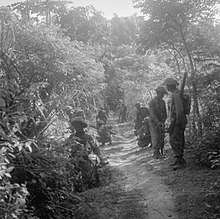
The British were charged with restoring order and civilian government in Java. The Dutch took this to mean pre-war colonial administration and continued to claim sovereignty over Indonesia.[29] The British and Indian troops did not, however, land on Java to accept the Japanese surrender until late September 1945. Lord Mountbatten's immediate tasks included the repatriation of some 300,000 Japanese, and freeing prisoners of war. He did not want, nor did he have the resources, to commit his troops to a long struggle to regain Indonesia for the Dutch.[47] The first British troops reached Jakarta in late September 1945, and arrived in the cities of Medan (North Sumatra), Padang (West Sumatra), Palembang (South Sumatra), Semarang (Central Java) and Surabaya (East Java) in October. In an attempt to avoid clashes with Indonesians, the British commander Lieutenant General Sir Philip Christison diverted soldiers of the former Dutch colonial army to eastern Indonesia, where Dutch reoccupation was proceeding smoothly.[30] Tensions mounted as Allied troops entered Java and Sumatra; clashes broke out between Republicans and their perceived enemies, namely Dutch prisoners, Dutch colonial troops (KNIL), Chinese, Indo-Europeans and Japanese.[30]
The first stages of warfare were initiated in October 1945 when, in accordance with the terms of their surrender, the Japanese tried to re-establish the authority they had relinquished to Indonesians in the towns and cities. Japanese military police killed Republican pemuda in Pekalongan (Central Java) on 3 October, and Japanese troops drove Republican pemuda out of Bandung in West Java and handed the city to the British, but the fiercest fighting involving the Japanese was in Semarang. On 14 October, British forces began to occupy the city. Retreating Republican forces retaliated by killing between 130 and 300 Japanese prisoners they were holding. Five hundred Japanese and two thousand Indonesians had been killed and the Japanese had almost captured the city six days later when British forces arrived.[30] The Allies repatriated the remaining Japanese troops and civilians to Japan, although about 1,000 elected to remain behind and later assisted Republican forces in fighting for independence.[48]
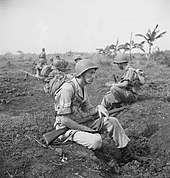
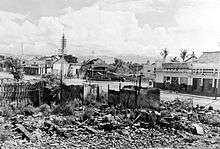
The British subsequently decided to evacuate the 10,000 Indo-Europeans and European internees in the volatile Central Java interior. British detachments sent to the towns of Ambarawa and Magelang encountered strong Republican resistance and used air attacks against the Indonesians. Sukarno arranged a ceasefire on 2 November, but by late November fighting had resumed and the British withdrew to the coast.[30][49] Republican attacks against Allied and alleged pro-Dutch civilians reached a peak in November and December, with 1,200 killed in Bandung as the pemuda returned to the offensive.[50] In March 1946, departing Republicans responded to a British ultimatum for them to leave the city of Bandung by deliberately burning down much of the southern half of the city in what is popularly known in Indonesia as the "Bandung Sea of Fire". The last British troops left Indonesia in November 1946, but by this time 55,000 Dutch troops had landed in Java.
Battle of Surabaya
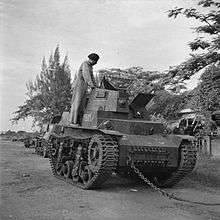
The Battle of Surabaya was the heaviest single battle of the revolution and became a national symbol of Indonesian resistance.[51] Pemuda groups in Surabaya, the second largest city in Indonesia, seized arms and ammunition from the Japanese and set up two new organisations; the Indonesia National Committee (KNI) and the People's Security Council (BKR). By the time the Allied forces arrived at the end of October 1945, the pemuda foothold in Surabaya city was described as "a strong unified fortress".[52]
— Sukarno[53]
In September and October 1945 Europeans and pro-Dutch Eurasians were attacked and killed by Indonesian mobs.[54] Ferocious fighting erupted when 6,000 British Indian troops landed in the city. Sukarno and Hatta negotiated a ceasefire between the Republicans and the British forces led by Brigadier Mallaby. Mallaby was killed on 30 October 1945 while he was travelling about Surabaya under a white flag to spread the news about the cease fire agreement[55] and rescue some stranded Mahratta troops, despite being warned of the danger by Force 136 troops.[56] Following the killing of Mallaby on 30 October,[52] the British sent more troops into the city from 10 November under the cover of air attacks. Although the European forces largely captured the city in three days, the poorly armed Republicans fought on until 29 November[57] and thousands died as the population fled to the countryside.
Despite the military defeat suffered by the Republicans and a loss of manpower and weaponry that would severely hamper Republican forces for the rest of the revolution, the battle and defence mounted by the Indonesians galvanised the nation in support of independence and helped garner international attention. For the Dutch, it removed any doubt that the Republic was a well-organised resistance with popular support.[51] It also convinced Britain to lie on the side of neutrality in the revolution,[51] and within a few years, Britain would support the Republican cause in the United Nations.
Installing the Netherlands Indies Civil Administration
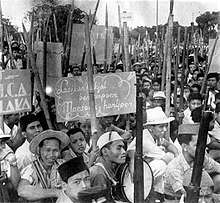
With British assistance, the Dutch landed their Netherlands Indies Civil Administration (NICA) forces in Jakarta and other key centres. Republican sources reported 8,000 deaths up to January 1946 in the defence of Jakarta, but they could not hold the city.[47] The Republican leadership thus established themselves in the city of Yogyakarta with the crucial support of the new sultan, Sri Sultan Hamengkubuwono IX. Yogyakarta went on to play a leading role in the revolution, which would result in the city being granted its own Special Territory status.[58] In Bogor, near Jakarta, and in Balikpapan in Kalimantan, Republican officials were imprisoned. In preparation for the Dutch occupation of Sumatra, its largest cities, Palembang and Medan, were bombed. In December 1946, Special Forces Depot (DST), led by commando and counter-insurgency expert Captain Raymond "Turk" Westerling, were accused of pacifying the southern Sulawesi region using arbitrary terror techniques, which were copied by other anti-Republicans. As many as 3,000 Republican militia and their supporters were killed in a few weeks.[59]
On Java and Sumatra, the Dutch found military success in cities and major towns, but they were unable to subdue the villages and countryside. On the outer islands (including Bali), Republican sentiment was not as strong, at least among the elite. They were consequently occupied by the Dutch with comparative ease, and autonomous states were set up by the Dutch. The largest, the State of East Indonesia (NIT), encompassed most of eastern Indonesia, and was established in December 1946, with its administrative capital in Makassar.[60]}
Diplomacy and military offensives
Linggadjati Agreement
The Linggadjati Agreement, brokered by the British and concluded in November 1946, saw the Netherlands recognise the Republic as the de facto authority over Java, Madura, and Sumatra. Both parties agreed to the formation of the United States of Indonesia by 1 January 1949, a semi-autonomous federal state with the monarch of the Netherlands at its head. The Republican-controlled Java and Sumatra would be one of its states, alongside areas that were generally under stronger Dutch influence, including southern Kalimantan, and the "Great East", which consisted of Sulawesi, Maluku, the Lesser Sunda Islands, and Western New Guinea. The Central National Committee of Indonesia (KNIP) did not ratify the agreement until February 1947, and neither the Republic nor the Dutch were satisfied with it.[12] On 25 March 1947 the Lower House of the Dutch parliament ratified a stripped-down version of the treaty, which was not accepted by the Republic.[61] Both sides soon accused the other of violating the agreement.
— former East Indies Governor H. J. van Mook's justification for the first Dutch "police action".[62]
Operation Product
At midnight on 20 July 1947, the Dutch launched a major military offensive called Operatie Product, with the aim of destroying the republic and regaining control of areas with natural resources in Java and Sumatra, thus covering the cost of the 100,000-strong Dutch military presence. Claiming violations of the Linggajati Agreement, the Dutch described the campaign as politionele acties ("police actions") to restore law and order. In the offensive, Dutch forces drove Republican troops out of parts of Sumatra, and East and West Java. The Republicans were confined to the Yogyakarta region of Java. The Dutch gained control of lucrative Sumatran plantations, and oil and coal installations, and in Java, control of all deep water ports.[63][64]

International reaction to the Dutch actions was negative. Neighbouring Australia and newly independent India were particularly active in supporting the Republic's cause in the UN, as were the Soviet Union and, most significantly, the United States. Dutch ships continued to be boycotted from loading and unloading by Australian waterside workers, a blockade that began in September 1945. The United Nations Security Council became directly involved in the conflict, establishing a Good Offices Committee to sponsor further negotiations, making the Dutch diplomatic position particularly difficult. A ceasefire, called for by UNSC resolution 27, was ordered by the Dutch and Sukarno on 4 August 1947.[65]
Renville Agreement

The United Nations Security Council brokered the Renville Agreement in an attempt to rectify the collapsed Linggarjati Agreement. The agreement was ratified in January 1948 and recognised a cease-fire along the so-called 'Van Mook line'; an artificial line which connected the most advanced Dutch positions.[67] Many Republican positions, however, were still held behind the Dutch lines. The agreement also required referenda to be held on the political future of the Dutch held areas. The apparent reasonableness of Republicans garnered much important American goodwill.[65]
Diplomatic efforts between the Netherlands and the Republic continued throughout 1948 and 1949. Political pressures, both domestic and international, hindered Dutch attempts to decide upon objectives. Similarly, Republican leaders faced great difficulty in persuading their people to accept diplomatic concessions. By July 1948 negotiations were in deadlock and the Netherlands pushed unilaterally towards Van Mook's federal Indonesia concept. The new federal states of South Sumatra and East Java were created, although neither had a viable support base.[68] The Netherlands set up the Bijeenkomst voor Federaal Overleg (BFO) (or Federal Consultative Assembly), a body comprising the leadership of the federal states, and charged with the formation of a United States of Indonesia and an interim government by the end of 1948. The Dutch plans, however, had no place for the Republic unless it accepted a minor role already defined for it. Later plans included Java and Sumatra but dropped all mention of the Republic. The main sticking point in the negotiations was the balance of power between the Netherlands High Representative and the Republican forces.[69]
Mutual distrust between the Netherlands and the Republic hindered negotiations. The Republic feared a second major Dutch offensive, while the Dutch objected to continued Republican activity on the Dutch side of the Renville line. In February 1948 the Siliwangi Division (35,000 men) of the Republican Army, led by Nasution, marched from West Java to Central Java; the relocation was intended to ease internal Republican tensions involving the Division in the Surakarta area. The Battalion, however, clashed with Dutch troops while crossing Mount Slamet, and the Dutch believed it was part of a systematic troop movement across the Renville Line. The fear of such incursions actually succeeding, along with apparent Republican undermining of the Dutch-established Pasundan state and negative reports, led to the Dutch leadership increasingly seeing itself as losing control.[70]
Operation Crow and General Offensive (Serangan Oemoem)
— General Sudirman, broadcast from his sickbed.[71]

Frustrated at negotiations with the Republic and believing it weakened by both the Darul Islam and Madiun insurgencies, the Dutch launched a military offensive on 19 December 1948 which it termed 'Operatie Kraai' (Operation Crow). By the following day it had conquered the city of Yogyakarta, the location of the temporary Republican capital. By the end of December, all major Republican held cities in Java and Sumatra were in Dutch hands.[1] The Republican president, vice president, and all but six Republic of Indonesia ministers were captured by Dutch troops and exiled on Bangka Island off the east coast of Sumatra. In areas surrounding Yogyakarta and Surakarta, Republican forces refused to surrender and continued to wage a guerrilla war under the leadership of Republican military chief of staff General Sudirman, who had escaped the Dutch offensives. An emergency Republican government, the Pemerintahan Darurat Republik Indonesia (PDRI), was established in West Sumatra.
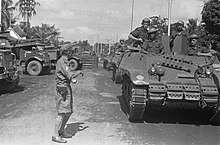
Although Dutch forces conquered the towns and cities in Republican heartlands on Java and Sumatra, they could not control villages and the countryside.[72] Republican troops and militia led by Lt. Colonel (later President) Suharto attacked Dutch positions in Yogyakarta at dawn on 1 March 1949. The Dutch were expelled from the city for six hours but reinforcements were brought in from the nearby cities of Ambarawa and Semarang that afternoon.[72] Indonesian fighters retreated at 12:00 pm and the Dutch re-entered the city. The Indonesian attack, later known in Indonesia as Serangan Oemoem (new spelling: Serangan Umum '1 March General Offensive'), is commemorated by a large monument in Yogyakarta. A large-scale attack against Dutch troops in Surakarta on 10 August the same year resulted in republican forces holding the city for two days.[73]
Once again, international opinion of the Dutch military campaigns was one of outrage, significantly in both the United Nations and the United States. In January 1949, the United Nations Security Council passed a resolution demanding the reinstatement of the Republican government.[17] United States aid specifically earmarked for Dutch Indonesia was immediately cancelled and pressure mounted within the US Congress for all United States aid to be cut off. This included Marshall Plan funds vital for Dutch post-World War II rebuilding that had so far totalled $US 1 billion.[74] The Netherlands Government had spent an amount equivalent to almost half of this funding their campaigns in Indonesia. That United States aid could be used to fund "a senile and ineffectual imperialism" encouraged many key voices in the United States – including those amongst the US Republican Party – and from within American churches and NGOs to speak out in support of Indonesian independence.[3]
Internal turmoil
Social revolutions
The so-called 'social revolutions' following the independence proclamation were challenges to the Dutch-established Indonesian social order, and to some extent a result of the resentment against Japanese-imposed policies. Across the country, people rose up against traditional aristocrats and village heads and attempted to exert popular ownership of land and other resources.[75] The majority of the social revolutions ended quickly; in most cases the challenges to the social order were quashed, although in East Sumatra, the sultanates were overthrown and there were mass killings of members of the aristocratic families.[76][77]
A culture of violence rooted in the deep conflicts that split the countryside during the revolution would repeatedly erupt throughout the whole second half of the 20th century.[76] The term 'social revolution' has been applied to a range of mostly violent activities of the left that included both altruistic attempts to organise real revolution and simple expressions of revenge, resentment and assertions of power. Violence was one of the many lessons learned during the Japanese occupation, and figures identified as 'feudal', including kings, regents, or simply the wealthy, were often attacked and sometimes beheaded. Rape became a weapon against 'feudal' women.[75] In the coastal sultanates of Sumatra and Kalimantan, for example, sultans and others whose authority had been shored-up by the Dutch, were attacked as soon as Japanese authority left. The secular local lords of Aceh, who had been the foundation of Dutch rule, were executed, although most of Indonesia's sultanates fell back into Dutch hands.
Most Indonesians lived in fear and uncertainty, particularly a significant proportion of the population who supported the Dutch or who remained under Dutch control. The popular revolutionary cry 'Freedom or Death' was often interpreted to justify killings under claimed Republican authority. Traders were often in particularly difficult positions. On the one hand, they were pressured by Republicans to boycott all sales to the Dutch; on the other hand, Dutch police could be merciless in their efforts to stamp out smugglers on which the Republican economy depended. In some areas, the term kedaulatan rakyat ('exercising the sovereignty of the people') – which is mentioned in the preamble of the Constitution and used by pemuda to demand pro-active policies from leaders – came to be used not only in the demanding of free goods, but also to justify extortion and robbery. Chinese merchants, in particular, were often forced to keep their goods at artificially low prices under threat of death.[75][78]
Communist and Islamist insurgencies
On 18 September 1948 an 'Indonesian Soviet Republic' was declared in Madiun, east of Yogyakarta, by members of the PKI and the Indonesian Socialist Party (PSI). Judging the time right for a proletarian uprising, they intended it to be a rallying point for revolt against "Sukarno-Hatta, the slaves of the Japanese and America".[25] Madiun however was won back by Republican forces within a few weeks and the insurgency leader, Musso, killed. RM Suryo, the governor of East Java, as well as several police officers and religious leaders, were killed by the rebels. This ended a distraction for the revolution,[25] and it turned vague American sympathies based on anti-colonial sentiments into diplomatic support. Internationally, the Republic was now seen as being staunchly anti-communist and a potential ally in the emerging global Cold War between the American-led 'free world' and the Soviet-led bloc.[79]
Members of the Republican Army who had come from Indonesian Hizbullah felt betrayed by the Indonesian Government. In May 1948, they declared a break-away regime, the Negara Islam Indonesia (Indonesian Islamic State), better known as Darul Islam. Led by an Islamic mystic, Sekarmadji Maridjan Kartosuwirjo, Darul Islam sought to establish Indonesia as an Islamic theocracy. At the time, the Republican Government did not respond, as they were focused on the threat from the Dutch. Some leaders of Masjumi sympathised with the rebellion. After the Republic regained all territories in 1950, the government took the Darul Islam threat seriously, especially after some provinces declared that they had joined Darul Islam. The rebellion was put down in 1962.
Transfer of sovereignty
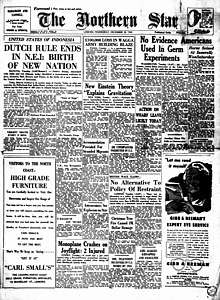
Soldiers beat a path for me to the topmost step of the big white palace. There I raised both hands high. A stillness swept over the millions.
"Alhamdulillah – Thank God," I cried. "We are free"The resilience of Indonesian Republican resistance and active international diplomacy set world opinion against the Dutch efforts to re-establish their colony.[3] The second 'police action' was a diplomatic disaster for the Dutch cause. The newly appointed United States Secretary of State Dean Acheson pushed the Netherlands government into negotiations earlier recommended by the United Nations but until then defied by the Netherlands. The Dutch–Indonesian Round Table Conference was held in The Hague from 23 August 1949 to 2 November 1949 between the Republic, the Netherlands, and the Dutch-created federal states. The Netherlands agreed to recognise Indonesian sovereignty over a new federal state known as the 'United States of Indonesia' (RUSI). It would include all the territory of the former Dutch East Indies with the exception of Netherlands New Guinea; sovereignty over which it was agreed would be retained by the Netherlands until further negotiations with Indonesia. The other issue on which Indonesia gave concessions was Netherlands East Indies debt. Indonesia agreed to responsibility for this sum of £4.3 billion, much of which was directly attributable to Dutch attempts to crush the revolution. Sovereignty was formally transferred on 27 December 1949, and the new state was immediately recognised by the United States of America.

Republican-controlled Java and Sumatra together formed a single state in the sixteen-state RUSI federation, but accounted for almost half its population. The other fifteen 'federal' states had been created by the Netherlands since 1945. These states were dissolved into the Republic over the first half of 1950. An abortive anti-Republic coup in Bandung and Jakarta by Westerling's Legion of Ratu Adil (APRA) on 23 January 1950 resulted in the dissolution of the populous Pasundan state in West Java, thus quickening the dissolution of the federal structure. Colonial soldiers, who were largely Ambonese, clashed with Republican troops in Makassar during the Makassar Uprising in April 1950. The predominantly Christian Ambonese were from one of the few regions with pro-Dutch sentiments and they were suspicious of the Javanese Muslim-dominated Republic, whom they unfavourably regarded as leftists. On 25 April 1950, an independent Republic of South Maluku (RMS) was proclaimed in Ambon but this was suppressed by Republican troops during a campaign from July to November. With the state of East Sumatra now being the only federal state remaining, it too folded and fell in line with the unitary Republic. On 17 August 1950, the fifth anniversary of his declaration of Indonesian independence, Sukarno proclaimed the Republic of Indonesia as a unitary state.[81][82][17]
Impacts

Although there is no accurate account of how many Indonesians died, they died in far greater numbers than the Europeans. Estimates of Indonesian deaths in fighting range from 45,000 to 100,000 and civilian dead exceeded 25,000 and may have been as high as 100,000.[83][84][85] A total of 1,200 British soldiers were killed or went missing in Java and Sumatra in 1945 and 1946, most of them Indian soldiers.[10] More than 5,000 Dutch soldiers lost their lives in Indonesia between 1945 and 1949. Many Japanese died; in Bandung alone, 1,057 died, only about half of whom died in actual combat, the rest killed in rampages by Indonesians. Seven million people were displaced on Java and Sumatra.[83][86]
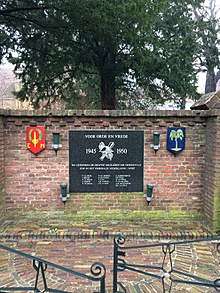
The revolution had direct effects on economic conditions; shortages were common, particularly food, clothing and fuel. There were in effect two economies – the Dutch and the Republican – both of which had to simultaneously rebuild after World War II and survive the disruptions of the revolution. The Republic had to set up all necessities of life, ranging from 'postage stamps, army badges, and train tickets' whilst subject to Dutch trade blockades. Confusion and ruinous inflationary surges resulted from competing currencies; Japanese, new Dutch money, and Republican currencies were all used, often concurrently.[87]
Indonesian independence was secured through a blend of both diplomacy and force. Despite their ill-discipline raising the prospect of anarchy, without pemuda confronting foreign and Indonesian colonial forces, Republican diplomatic efforts would have been futile. The revolution is the turning point of modern Indonesian history, and it has provided the reference point and validation for the country's major political trends that continue to the present day. It gave impetus to communism in the country, to militant nationalism, to Sukarno's 'guided democracy', to political Islam, the origins of the Indonesian army and its role in Indonesian power, the country's constitutional arrangements, and the centralism of power in Indonesia.[88]
The revolution destroyed a colonial administration ruled from the other side of the world, and dismantled with it the raja, seen by many as obsolete and powerless. Also, it relaxed the rigid racial and social categorisations of colonial Indonesia. Tremendous energies and aspirations were created amongst Indonesians; a new creative surge was seen in writing and art, as was a great demand for education and modernisation. It did not, however, significantly improve the economic or political fortune of the population's poverty-stricken peasant majority; only a few Indonesians were able to gain a larger role in commerce, and hopes for democracy were dashed within a decade.[88]
See also
Notes
- from 1945
- from 1945
- from 1946
- until 1946
- merged to United States of Indonesia in 1949
- Reid 1974, p. 152.
- Vickers 2005, p. 115.
- Friend 2003, p. 38.
- Tjandraningsih, Christine (9 September 2009). "Japanese recounts role fighting to free Indonesia". Kyodo News. Retrieved 24 March 2020.
- Khan, AG (12 May 2012). "Indian Muslim soldiers: heroic role in Indonesia's liberation". The Milli Gazette. Retrieved 24 March 2020.
- Prastiwi, Arie Mega (15 August 2016). "Kisah Rahmat Shigeru Ono, Tentara Jepang yang 'Membelot' ke NKRI". liputan6.com (in Indonesian). Retrieved 13 May 2020.
- "The War for Independence: 1945 to 1950". Gimonca. Retrieved 23 September 2015.
- https://www.groene.nl/artikel/wie-telt-de-indonesische-doden
- Stichting 1945 – 1950 Ubachsberg.
- Kirby 1969, p. 258.
- Beck 2008.
- Friend 2003, p. 35.
- Vandenbosch 1931, pp. 1051–106.
- Kahin 1980, pp. 113–120.
- Vickers 2005, p. 85.
- Ricklefs 1991, p. 207.
- Frederick & Worden 1993.
- Ricklefs 1991, p. 213.
- Taylor 2003, p. 325.
- Reid 1974, p. 30.
- Note: In fact, 05 was used for the year meaning Japanese imperial year 2605.
- Kahin 2000, pp. 1–4.
- Ricklefs 1991, pp. 214–215.
- Lockwood 1975.
- Friend 2003, p. 32.
- Cribb 1986, pp. 72–85.
- Ricklefs 1991, pp. 215–216.
- Vickers 2005, p. 198.
- Vickers 2005, p. 97.
- Ricklefs 1991, p. 216.
- Reid 1974, p. 49.
- Fenton-Huie 2005.
- Reid 1981, pp. 107–157.
- Note: These legal testimonies formerly designated top secret have been made public and are available online. See: Van der Molen, Pia Bussemaker, Herman Archief van Tranen website (2012). Document: 125_A_B_C_D_E_F Online archive
- Vickers 2005, p. 98.
- Bussemaker 2005.
- Former KNIL POWs were still recuperating in Allied military bases outside of Indonesia (e.g. Japan and the Philippines). The British in fact prohibited Dutch troops from entering the country during most of the Bersiap period.
- Kahin 1952, p. 140.
- Ricklefs 1991, p. 214.
- Friend 2003, p. 33.
- Ricklefs 1991, p. 215.
- Most PETA and Heiho members did not yet know about the declaration of independence.
- Matanasi, Petrik (5 October 2018). "Pertarungan Abadi di Tubuh TNI: Eks KNIL vs Eks PETA". tirto.id (in Indonesian). Retrieved 3 December 2019.
- Reid 1974, p. 78.
- Bidien 1945, pp. 345–348.
- Ashton & Hellema 2001, p. 181.
- Vickers 2005, p. 99.
- Tjandraningsih 2011, p. 3.
- McMillan 2005, pp. 306–307.
- Reid 1974, p. 54.
- Ricklefs 1991, p. 217.
- Parrott 1975, pp. 87–111.
- Sukarno & Adams 1965, p. 228.
- Frederick 1989, pp. 237–243.
- Parrott 1975, p. 75.
- Heren 2010, The Death Knell.
- Jessup 1989.
- Friend 2003, p. 420.
- Ricklefs 1991, p. 224.
- Kahin 1952, pp. 355,357.
- Kahin 1952, p. 206.
- van Mook 1949, p. 298.
- Reid 1974, pp. 111–112.
- Ricklegs 1991, p. 225.
- Ricklefs 1991, p. 226.
- Kahin 1952, p. 233.
- Kahin 1952, p. 229.
- Reid 1974, p. 149.
- Reid 1974, p. 150.
- Reid 1974, pp. 149–151.
- Kodam VI/Siliwang 1968, cited in Reid (1974, p. 152)
- Reid 1974, p. 153.
- Reid 1974, p. 161.
- Friend 2003, p. 37.
- Vickers 2005, pp. 101–104.
- Colombijn & Linblad 2002, pp. 143–173.
- Said 1973, pp. 145–186.
- Reid 1974, p. 60.
- Ricklefs 1991, p. 230.
- Sukarno & Adams 1965, pp. 262–263.
- Reid 1974, pp. 170–172.
- Ricklefs 1991, pp. 232–233.
- Vickers 2005, p. 100.
- Friend 1988, pp. 228 and 237.
- Pendit 1988; Stoler 1985, p. 103; Toer, Toer & Kamil 2005a; Toer, Toer & Kamil 2005b; Toer, Toer & Kamil 2005c; Toer, Toer & Kamil 2014, all cited in Vickers (2005, p. 100)
- Documentary film Tabee Toean, 1995. Director: Tom Verheul. Combination of footage and stories of Dutch war veterans.
- Vickers 2005, p. 101.
- Reid 1974, pp. 170–171.
References
- "Stichting 1945 – 1950 Ubachsberg". 1945-1950ubachsberg.nl. Archived from the original on 10 November 2013. Retrieved 3 September 2013.
- Ashton, Nigel John; Hellema, Duco (2001). Unspoken Allies: Anglo-Dutch Relations Since 1780. Amsterdam University Press. ISBN 978-90-485-0585-2.
- Bidien, Charles (5 December 1945). "Independence the Issue". Far Eastern Survey. 14 (24): 345–348. doi:10.1525/as.1945.14.24.01p17062. JSTOR 3023219.
- Beck, Sanderson (2008). South Asia, 1800-1950. Australia: World Peace Communications. ISBN 9780979253232.
- Bussemaker, H.Th. (2005). Bersiap! Opstand in het paradijs (in Dutch). Zutphen: Walburg Pers. ISBN 90-5730-366-3.
- Colombijn, Freek; Linblad, J. Thomas, eds. (2002). Roots of Violence in Indonesia: Contemporary Violence in Historical Perspective. Koninklijk Instituut Voor de Tropen. ISBN 90-6718-188-9.
- Cribb, Robert (1986). "A revolution delayed: the Indonesian Republic and the Netherlands Indies, August–November 1945". Australian Journal of Politics and History. The Australian National University. 32 (1).
- Fenton-Huie, Shirley h. (2005). The Forgotten Ones: Women and Children Under Nippon. (Sydney: Angus and Robertson. ISBN 9780207170775.
- Frederick, Willam H. (1989). Visions and Heat: The Making of the Indonesian Revolution. Athens, Ohio: Ohio University Press. ISBN 0-8214-0906-9.
- Frederick, William H.; Worden, Robert L., eds. (1993). "The National Revolution, 1945–50". Country Studies, Indonesia. GPO for the Library of Congress.
- Friend, Theodore (1988). Blue Eyed Enemy: Japan against the West in Java and Luzon, 1942–1945. Princeton University Press. ISBN 978-0-691-05524-4.
- Friend, Theodore (2003). Indonesian Destinies. The Belknap Press of Harvard University Press. ISBN 0-674-01834-6.
- Heren, Patrick (November 2010). "The Death Knell of the British Empire". Standpoint. Archived from the original on 4 November 2011. Retrieved 2 October 2011.
- Jessup, John E. (1989). A Chronology of Conflict and Resolution, 1945–1985. New York: Greenwood Press. ISBN 0-313-24308-5.
- Kahin, George McTurnan (1952). Nationalism and Revolution in Indonesia. Ithaca, New York: Cornell University Press. ISBN 0-8014-9108-8.
- Kahin, George McTurnan (1980). "In Memoriam: Mohammad Hatta (1902–1980)" (PDF). Indonesia. Southeast Asia Program Publications at Cornell University. 30 (30): 113–120. doi:10.2307/3350997. hdl:1813/53609. JSTOR 3350997.
- Kahin, George McTurnan (2000). "Sukarno's Proclamation of Indonesian Independence" (PDF). Indonesia. Ithaca, NY: Cornell Modern Indonesia Project. 69 (69): 1–4. doi:10.2307/3351273. hdl:1813/54189. JSTOR 3351273.
- Kahin, George McTurnan; Audrey Kahin (2003). Southeast Asia: A Testament. London: Routledge Curzon. ISBN 0-415-29975-6.
- Kirby, Woodburn S (1969). War Against Japan, Volume 5: The Surrender of Japan. HMSO. p. 258.
- McMillan, Richard (2005). The British Occupation of Indonesia 1945–1946. Melbourne: Routledge. ISBN 0-415-35551-6.
- Lockwood, Rupert (1975). Black Armada: Australia and the Struggle for Indonesian Independence 1942-49. Australasian Book Society.
- van Mook, H. J. (July 1949). "Indonesia". International Affairs. Royal Institute of International Affairs. 25 (3): 278. JSTOR 3016666.
- Parrott, J. G. A. (October 1975). "Who Killed Brigadier Mallaby?" (PDF). Indonesia. Cornell Modern Indonesia Project. 20 (20): 87–111. doi:10.2307/3350997. hdl:1813/53609. JSTOR 3350997. Retrieved 27 November 2006.
- Pendit, Nyoman S. (1988) [1954]. Bali Berjuang (2nd ed.). Jakarta: Gunung Agung. ISBN 9789799954114.
- Pramoedya Anwar Toer; Koesalah Soebagyo Toer; Ediati Kamil (2005). Kronik Revolusi Indonesia Vol I (1945) (in Indonesian). Kepustakaan Populer Gramedia. ISBN 9789799023292.
- Pramoedya Anwar Toer; Koesalah Soebagyo Toer; Ediati Kamil (2005). Kronik Revolusi Indonesia Vol II (1946) (in Indonesian). Kepustakaan Populer Gramedia. ISBN 9789799023308.
- Pramoedya Anwar Toer; Koesalah Soebagyo Toer; Ediati Kamil (2005). Kronik Revolusi Indonesia Vol III (1947) (in Indonesian). Kepustakaan Populer Gramedia. ISBN 9789799023469.
- Pramoedya Anwar Toer; Koesalah Soebagyo Toer; Ediati Kamil (2014). Kronik Revolusi Indonesia Vol IV (1948) (in Indonesian). Kepustakaan Populer Gramedia. ISBN 9789799106896.
- Reid, Anthony (1974). The Indonesian National Revolution 1945–1950. Melbourne: Longman. ISBN 0-582-71046-4.
- Reid, Anthony (1981). "Indonesia: revolution without socialism". In Jeffrey, Robin (ed.). Asia: the Winning of Independence. Macmillan. pp. 113–162. ISBN 9780333278574.
- Ricklefs, M.C. (1991). A History of Modern Indonesia Since c.1300. San Francisco: Stanford University Press. ISBN 1349227005.
- Said, H. Mohammed (1973). "What was the Social Revolution of 1946" in East Sumatra?" (PDF). Indonesia. Ithaca, NY: Cornell Modern Indonesia Project. 15 (April 1973): 145–186. doi:10.2307/3350795. JSTOR 3350795.
- Stoler, Ann (1985). Capitalism and Confrontation in Sumatra's Plantation Belt, 1870–1979. New Haven: Yale University Press. ISBN 9780472082193.
- Sukarno; Adams, Cindy (1965). Sukarno: An Autobiography. Bobbs-Merrill.
- Taylor, Jean Gelman (2003). Indonesia: Peoples and History. Yale University Press. p. 325. ISBN 0-300-10518-5.
- Tjandraningsih, Christine T. (19 August 2011). "Indonesians to get book on Japanese freedom fighter". Japan Times. Retrieved 29 October 2018.
- Vandenbosch, Amry (1931). "Nationalism in Netherlands East India". Pacific Affairs. Pacific Affairs, University of British Columbia. 4 (12): 1051–1069. doi:10.2307/2750579. JSTOR 2750579.
- Vickers, Adrian (2005). A History of Modern Indonesia. New York: Cambridge University Press. pp. 85–112. ISBN 0-521-54262-6.
Further reading
- Anderson, Ben (1972). Java in a Time of Revolution: Occupation and Resistance, 1944–1946. Ithaca, N.Y.: Cornell University Press. ISBN 0-8014-0687-0.
- Cribb, Robert (1991). Gangster and Revolutionaries: The Jakarta People's Militia and the Indonesian Revolution 1945–1949. Sydney, Australia: ASSA Southeast Asian Publications Series – Allen and Unwin. ISBN 0-04-301296-5.
- Drooglever, P. J.; Schouten, M. J. B.; Lohanda, Mona (1999). Guide to the Archives on Relations between the Netherlands and Indonesia 1945–1963. The Hague, Netherlands: ING Research Guide.
- George, Margaret (1980). Australia and the Indonesian Revolution. Melbourne University Press. ISBN 0-522-84209-7.
- Heijboer, Pierre (1979). De Politionele Acties (in Dutch). Haarlem: Fibula-van Dishoeck.
- Holst Pellekaan, R.E. van, I.C. de Regt "Operaties in de Oost: de Koninklijke Marine in de Indische archipel (1945–1951)" (Amsterdam 2003).
- Ide Anak Agug Gde Agung (1996) (translated to English by Linda Owens)From the Formation of the State of East Indonesia Towards the Establishment of the United States of Indonesia Jakarta: Yayasan Obor Indonesia ISBN 979-461-216-2 (Original edition Dari Negara Indonesia Timur ke Republic Indonesia Serikat 1985 Gadjah Mada University Press)
- Jong, Dr. L. de (1988). Het Koninkrijk der Nederlanden in de Tweede Wereldoorlog, deel 12, Sdu, 's-Gravenhage (an authoritative standard text on both the political and military aspects, in Dutch)
- Kahin, Audrey (1995). Regional Dynamics of the Indonesian Revolution. University of Hawaii Press. ISBN 0-8248-0982-3.
- Kahin, George McTurnan (1952) [1951]. Nationalism and Revolution in Indonesia. Ithaca, NY: Cornell University Press. OCLC 406170.
- Kodam VI/Siliwang (1968). Siliwangi dari masa kemasa (in Indonesian). Fakta Mahjuma.
- Lucas, A. (1991). One Soul One Struggle. Region and Revolution in Indonesia. St. Leonards, Australia: Allen & Unwin. ISBN 0-04-442249-0.
- McMillan, Richard (2005). The British Occupation of Indonesia 1945–1946. New York, NY: Routledge. ISBN 0-415-35551-6.
- Payne, Robert (1947). The Revolt In Asia. New York: John Day.
- Poeze, Harry A. (2007). Verguisd en vergeten. Tan Malaka, de linkse beweging en de Indonesische Revolutie 1945–1949. KITLV. p. 2200. ISBN 978-90-6718-258-4.
- Taylor, Alastair M. (1960). Indonesian Independence and the United Nations. London: Stevens & Sons. ASIN B0007ECTIA.
- Yong Mun Cheong (2004). The Indonesian Revolution and the Singapore Connection, 1945–1949. Leiden, Netherlands: KITLV Press. ISBN 90-6718-206-0.
External links
![]()
- Parallel and Divergent Aspects of British Rule in the Raj, French Rule in Indochina, Dutch Rule in the Netherlands East Indies (Indonesia), and American Rule in the Philippines.
- Radio address by Queen Wilhelmina on 7 December 1942.
- Dutch Proposals for Indonesian Settlement 6 November 1945.
- Dutch Proposals for Indonesian Settlement 10 Feb 1946.
- Text of the Linggadjati Agreement 10 Feb 1946.
- The Renville Political Principles 17 January 1948.
- Dutch Queen Signs away an Empire (1950), newsreel on the British Pathé YouTube Channel
